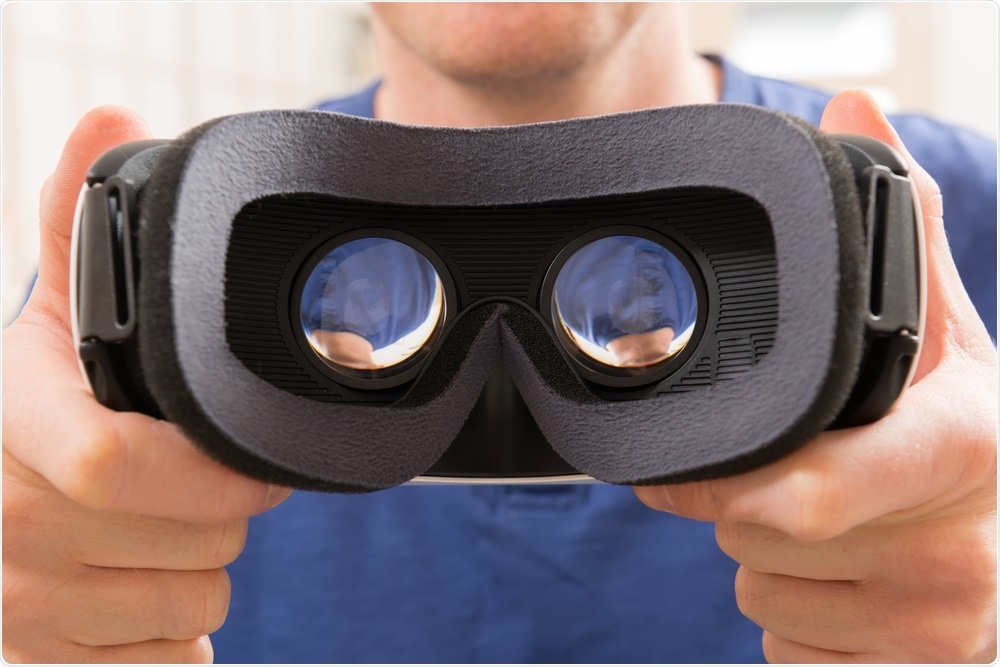Pain relief typically involves anesthetic but VR also provides a new technology to limit some of the pain experienced in medical procedures such as bladder cancer by immersing patients into pleasant environments.

Virtual Reality. Image Credit: Monika Wisniewska/Shutterstock.com
Virtual waterfalls and environmental immersion as pain relief during cystoscopies
Medical treatments can include painful diagnostic treatments with few methods to relieve some of the pain. For instance, identifying and treating bladder cancer typically requires checking the bladder through a cystoscopy, a treatment perceived by patients as unpleasant and painful, but new methods have been applied to avoid some of the discomfort experienced during the procedure.
In new research presented at the Annual Congress of the European Association of Urology (EAU21) in 2021, researchers have demonstrated that being immersed in a stunning 'virtual' Icelandic landscape can reduce the pain caused by uncomfortable medical procedures.
The study used physiological and behavioral data from patients equipped with and without virtual reality (VR) headsets that underwent rigid cystoscopies.
Cystoscopies involve the insertion of a rigid telescope through the urethra into the bladder to check for bladder cancer and are a key diagnostic process for the disease. However, some patients avoid follow-up due to the pain incurred during cystoscopy and as a result, suffer from the irreversible development of the disease.
Alternatives to rigid cystoscopies exist, including flexible cystoscopy, which is less painful, but certain treatments can only be done with a rigid cystoscopy. Although it can also be performed under both general and spinal anesthetic, those procedures bring the additional risk of complications during the cystoscopy.
In response, researchers have adapted the use of virtual reality (VR) to alleviate some of the pain incurred during the process. VR has been shown to be an effective pain relief tool in previous medicinal treatments, including when dressings are changed, but these applications have patients generally held upright and the VR experience itself being interactive.
However, the newly developed method consists of a VR experience encompassing a visual and auditory immersive experience for patients held horizontally as they are undergoing cystoscopies.
Lasting benefits and wider applicability for VR across other medical treatments
The study conducted by Dr. Wojciech Krajewski and colleagues at the Wrocław Medical University in Poland used data from 103 patients with an average age of 66 years listed for rigid cystoscopy with just local, intraurethral anesthesia.
Patients included individuals that were there for their first diagnosis and others required to follow up having experienced the procedure (without VR) in the past. Individuals were then randomized to undergo classic cystoscopy or the procedure that included VR goggles and headphones presenting an image of the Skógafoss waterfall in Iceland.
First, researchers evaluated the level of fear as well as anxiety and depression of individuals prior to the procedure. Then, the team measured blood pressure, oxygen saturation, and heart rate in patients during the cystoscopy, which was complemented with pain-related observations using a measurement score called FLACC that includes observing face, legs, consolability, and crying. Once the procedure ended, patients then rated the pain perception and nausea related to the cystoscopy.
Findings showed that the level of pain was lower in the VR group compared to the control group. Although feelings such as nausea and vertigo were higher with headsets and goggles, patients found it bearable and none of the procedures had to stop as a result of this feeling.
Physiologically, blood pressure and heart rate increased in all patients during the procedure, but the increase was not as high in the VR group. These findings were consistent for both sexes as well as for patients that were having their first and follow-up cystoscopies.
Cystoscopy is uncomfortable for patients and they can be anxious about it. My colleagues and I were keen to find new ways to make them more comfortable and had seen VR technology used for younger patients to alleviate pain in interactive ways. In this instance, we wanted to try presenting a calming image, more suited to older patients, and see if we could better support them during their procedures."
Dr. Krajewski
Indeed, adapting previous methods of VR pain relief provided a novel treatment method, which could be further adapted to suit other procedures.
"Patients reported less pain, and this was also reflected in our observations of their experience. VR is certainly an option for pain reduction in cystoscopies and we are looking into whether it will have the same effect in other medical interventions such as lithotripsy to break down kidney stones or prostate biopsy."
Improving patients' experience of the care they receive is as important as improving treatment outcomes. While it makes sense to avoid general anesthesia whenever possible, telescopic bladder examinations under local anesthetic can be very uncomfortable and frightening for some patients.
This study increases our understanding of how virtual reality can distract patients and reduce their anxiety and pain. What's needed now is a larger trial, which would also do a cost-benefit analysis, to determine whether this approach should be considered as part of standard clinical practice."
Professor James N'Dow, University of Aberdeen
Addressing such limitations and opportunities to expand the implementation of VR offers promising potential as an alternative method for pain relief. The authors are optimistic that the technology could be used for other uncomfortable or painful procedures to help reduce patient pain.